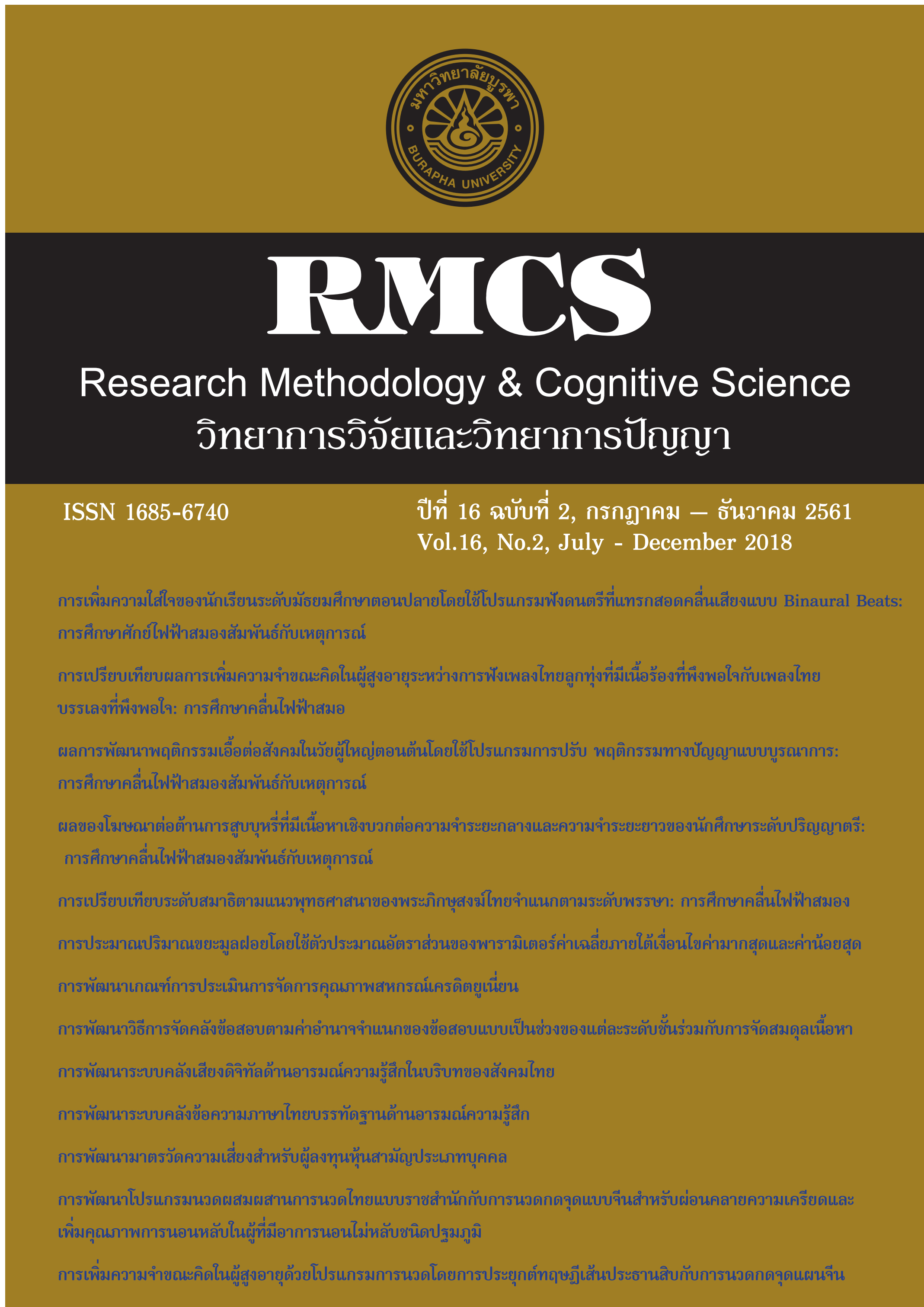The Effectiveness of Listening to Pleasant Thai Country Music Compared to Pleasant Thai Classical Music for Enhancing Working Memory in Older Adults: An Electroencephalogram Study
Main Article Content
Abstract
Listening to pleasant music can enhance brain functions. The objectives of this research were to develop the pleasant music program and then to investigate its effects on working memory, and on the changes in brain wave patterns in older adults, as they responded to a working memory test. The participants were sixty older adults from the senior citizens club, Trat hospital, who were randomly assigned to Thai country music (n=20), to Thai classical music (n =20), and to a control group who received no listening material (n=20). Data were collected using a computerized working memory test and the EEG recording system from Neuroscan. The t-test and One-way Anova were used to analyze the data.
The results showed that each of the two music programs consisted of six music tracks of 25-minute duration; one program involved pleasant Thai country music, the other pleasant Thai classical music. After the experiment, the Thai country music and Thai classical music groups showed a significant increase in the accuracy score on the counting span task when compared to before-experiment conditions (p < .05).
After the experiment, both the Thai country music and the Thai classical music groups showed a significant increase in upper alpha ERD% during the counting span task at F3, C3 and P3 electrode sites when compared to the control group (p < .05). However, there was no difference in upper alpha ERD% between the Thai country music and the Thai classical music groups and significant increased in theta ERS% at FP1, FP2, F7, F3, FZ, F4, CZ, PZ and O1 electrode sites when compared to the control group (p < .05).
Article Details
References
รัชนี นามจันทรา. (2553). การฟื้นฟูสภาพผู้สูงอายุที่มีสภาวะสมองเสื่อม. วารสาร มฉก.วิชาการ, 14(27), 137-150.
วีรศักดิ์ เมืองไพศาล. (2553). สุขภาพดีสมใจในวัยสูงอายุ. กรุงเทพฯ: ซีเอ็ดยูเคชั่น.
สุนิสา สมคิด. (2558). YOUNGER EVERYDAY. ชีวจิตรายปักษ์, 17, 39.
อัญชนา จุลศิริ และเสรี ชัดแช้ม. (2556). ผลของการฟังดนตรีไทยเดิมที่พึงพอใจต่อการเพิ่มความจำขณะคิดในผู้สูงอายุ: กรณีศึกษาคลื่นไฟฟ้าสมอง. วิทยาการวิจัยและวิทยาการปัญญา, 11(1), 1-19.
อัญชนา จุลศิริ และเสรี ชัดแช้ม. (2557). การเพิ่มความจำขณะคิดในผู้สูงอายุ. วารสารการพยาบาลและการศึกษา, 7(1), 16-25.
Borella, E., Carretti, B., Grassi, M., Nucci, M., & Sciore, R. (2014). Are age-related differences between young and older adults in an affective working memory test sensitive to the music effects?. Frontiers in
Aging Neuroscience, 6, 1-9.
Borella, E., Carbone, E., Pastore, M., De Beni, R., & Carretti, B. (2017). Working memory training for healthy older adults: The role of individual characteristics in explaining short-and long-term gains. Frontiers in
Human Neuroscience, 11, 1-21.
Burke, S. N., & Barnes, C. A. (2006). Neural plasticity in the ageing brain. Nature Reviews Neuroscience, 7(1), 30-40.
Cabeza, R., Anderson, N. D., Locantore, J. K., & McIntosh, A. R. (2002). Aging gracefully: compensatory brain activity in high-performing older adults. Neuroimage, 17(3), 1394-1402.
Edmonds, W. A., & Kennedy, T. D. (2017). An applied guide to research designs: Quantitative, qualitative, and mixed methods. California: Sage Publications.
Fukui, H., & Toyoshima, K. (2008). Music facilitate the neurogenesis, regeneration and repair of neurons. Medical Hypotheses, 71(5), 765-769.
Garcia-Segura, L. M. (2009). Hormones and brain plasticity. Oxford: Oxford University Press.
Gathercole, S. E., & Alloway, T. P. (2007). Understanding working memory: A classroom guide. London: Proter House.
Gevins, A., & Smith, M. E. (2000). Neurophysiological measures of working memory and individual differences in cognitive ability and cognitive style. Cerebral Cortex, 10(9), 829-839.
Grabner, R. H., Fink, A., Stipacek, A., Neuper, C., & Neubauer, A. C. (2004). Intelligence and working memory systems: evidence of neural efficiency in alpha band ERD. Cognitive Brain Research, 20(2), 212-
225.
Klimesch, W. (1999). EEG alpha and theta oscillations reflect cognitive and memory performance: a review and analysis. Brain Research Reviews, 29(2), 169-195.
Koelsch, S. (2014). Brain correlates of music-evoked emotions. Nature Reviews Neuroscience, 15(3), 170-180.
Lima, C. F., & Castro, S. L. (2011). Emotion recognition in music changes across the adult life span. Cognition and Emotion, 25(4), 585-598.
Macpherson, H. N., White, D. J., Ellis, K. A., Stough, C., Camfield, D., Silberstein, R., & Pipingas, A. (2014). Age-related changes to the neural correlates of working memory which emerge after midlife. Frontiers
in Aging Neuroscience, 6, 1-10.
Mattson, M. P., & Magnus, T. (2006). Ageing and neuronal vulnerability. Nature Reviews Neuroscience, 7(4), 278-294.
Mora, F., Segovia, G., & del Arco, A. (2007). Aging, plasticity and environmental enrichment: structural changes and neurotransmitter dynamics in several areas of the brain. Brain Research Reviews, 55(1), 78-
88.
Nissim, N. R., O’Shea, A. M., Bryant, V., Porges, E. C., Cohen, R., & Woods, A. J. (2017). Frontal structural neural correlates of working memory performance in older adults. Frontiers in Aging Neuroscience, 8,
1-7.
Osaka, I., Sauve, G., Zhang, R., Kowalewski, T., & McCullough, R. D. (2007). Novel Thiophene‐Thiazolothiazole Copolymers for Organic Field‐Effect Transistors. Advanced Materials, 19(23), 4160-4165.
Perlstein, W. M., Elbert, T., & Stenger, V. A. (2002). Dissociation in human prefrontal cortex of affective influences on working memory-related activity. Proceedings of the National Academy of Sciences, 99(3),
1736-1741.
Rypma, B., & D'Esposito, M. (2000). Isolating the neural mechanisms of age-related changes in human working memory. Nature Neuroscience, 3(5), 509-515.
Salimpoor, V. N., Benovoy, M., Larcher, K., Dagher, A., & Zatorre, R. J. (2011). Anatomically distinct dopamine release during anticipation and experience of peak emotion to music. Nature Neuroscience, 14(2),
257-262.

